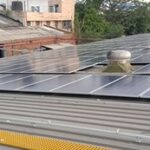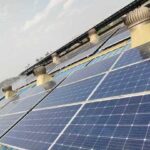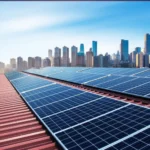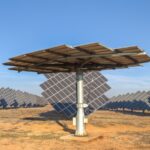What Is an Array Junction Box in Solar PV Modules? | Complete Guide
What Is an Array Junction Box in Solar PV Modules? | Complete Guide
An Array Junction Box, AJB, is used to connect the photovoltaic strings in parallel. The combined DC power is fed to the photovoltaic inverter. It includes photovoltaic string protection, overvoltage protection and a DC output switch isolator. The AJB can be customized for different configurations, based on the number of strings of solar panel modules used in the layout. AJB have the following component
- Enclosure
- PV fuses
- Surge Protection Device
- DC Disconnector/Isolator
- Cable Glands/Connectors
1. Enclosure:
The combiner box enclosures are usually made of thermoset (eg. GRP or polyester), or thermoplastic (polycarbonate) material, and come with IP65 protection. Enclosures come in various sizes, based on the number of input strings. The protection features required also contribute to the changes in the enclosure needed. Enclosure should be fire-resistant with self-extinguishing property. It should be UV-resistant and halogen–free and should also have a good mechanical impact resistance, preferably greater than IK 08.
2. PV fuse:
PV fuse or photovoltaic fuse, of the range 1A to 32A are easily available in market. The PV fuses are used for overcurrent protection.
PV fuse selection:-
Nsr = No. of PV modules in series per PV string
Npl = No. of PV strings in parallel per PV sub-array
Isc = Short-circuit current of one module at Standard Test Conditions (STC)
Voc = Open circuit voltage of one PV module at STC
Calculations to verify volts and amps:
• Fuse voltage rating ≥ 1.20 x Voc x Nsr
• Fuse amp rating ≥ 1.56 x Isc
For Example:-
Let’s assume that
No. of PV module in strings are: – 20 nos. (Nsr )
No. of PV string in parallel per PV sub array = 16 (Npl)
Isc = 8.6 Amp
Voc=37.2 V
Fuse amp rating ≥1.56*8.6 A ≥13.41 A
As per the standard fuse available in market, a 15A fuse should be used here.
Voltage rating of Fuse ≥1.2*37.2*20 V ≥ 892.8 V
As per the standard fuse available in market, a 1000 V DC fuse should be used to meet this requirement.
3. Surge Protection Device:
SPD or Surge Protection Device is used in the AJB/SCB. It protects electrical and electronic equipment from the power surges and voltage spikes. SPD diverts the excess voltage and current from transient or surge into ground through earthing system.
Selection Of SPDs according to the voltage protection level Vp:
Every SPD has a maximum voltage protection level specified for operation & diverts the excess energy in ground. The protection voltage level of SPD is usually kept at 20% less than dielectric strength & greater than operating voltage of PV system.
4. DC Disconnector /Isolator:
DC Disconnector/Isolator is a switch used to disconnect the power supply between PV string & inverter. It is recommended to be placed before the inverter, to disconnect the DC side of the system when required.
Selection criteria for PV isolator
Initial conditions for specifying PV disconnectors:
Nsr = No. of PV module in series per PV string
Npl= No. of PV string in parallel per PV sub-array
Isc = Short-circuit current of one PV module at Standard Test Conditions
Voc = Open circuit voltage of one PV module at STC
• Circuit breaker voltage rating ≥ 1.20 x Voc x Nsr Volt
• PV Output current rating ≥ 1.56 x Isc x Npl Amp
For example:- Let’s we assume that
No. of PV module in strings are = 20 nos. ( Nsr )
No. of PV string in parallel per PV sub array = 16 ( Npl)
Isc = 8.6 Amp
Voc=37.2 V
Circuit breaker voltage ≥ 1.20*37.2*20 Volt ≥892.8 Volt
As per standard available circuit breakers in market, it should be 1000 V DC Disconnector.
Current rating of isolator ≥1.56 x Isc x Npl Amp ≥1.56*8.6*16 Amp ≥214.65 Amp
As per standard available circuit breakers in market, it should be 225 Amp isolator.
5. Cable Glands/Connectors:
Every solar system is outdoor type, so AJB component should be IP65 protected & UV protected. There are two options with cable entry in AJB.
1. Cable Gland
2. MC4 connector.
Cable glands require the sealing arrangement after the connection inside AJB to outside systems is done. MC4 Connectors have the male female socket for connection, and hence do not require sealing to maintain the IP protection. MC4 connectors have the limitation of current capacity. In low rating, 30 A for string level MC4 is the best option. In case of AJB, output rating of more than 30Amp cable gland is suitable.
Suggested Articles

How Azimuth Angle Impacts Solar Panel Efficiency for Homes, Industries, and Commercial Buildings
Discover how solar panel azimuth impacts energy generation in homes, industries, and commercial buildings. Maximize efficiency with correct orientation.

How DISCOMs Implement Net Metering for Solar Power Plants
Discover the process of net metering implementation by DISCOMs for solar power plants. Understand the benefits, billing mechanism, and how it maximizes solar energy utilization.

India and Japan Strengthen Renewable Energy Cooperation
India and Japan have initiated a partnership under the Asia Energy Transition Initiative (AETI) to support India’s clean energy transition. India has set an ambitious target of achieving net-zero by 2070, while Japan aims to achieve the same by 2050.

6 Innovative Applications of Solar Energy You Should Know About
Explore how solar energy is revolutionizing daily life and industries. From solar-powered transport to smart cities, discover six groundbreaking solar applications shaping a cleaner, smarter future.

Solar Industry Faces Growing Losses from Underperforming Equipment
According to the Raptor Maps’ Global Solar Report, the amount of power loss due to equipment anomalies has nearly doubled from 1.61% in 2019 to 3.13% in 2022. This trend is expected to continue, with anomaly-driven power loss potentially growing to almost 6% by 2025.

India and IMT-GT JBC Sign MoU to Boost Energy Efficiency in Southeast Asia
The first meeting of the G20 Energy Transitions Working Group was held in Bengaluru, India, and was a success, with participants sharing a consensus on the priority areas of energy security and diversified supply chains.

Solar Rooftop Subsidy: Why It’s Time for a Change of Mindset
While solar rooftop subsidies help reduce upfront costs, true adoption requires a mindset shift. This guide discusses why businesses and homeowners should focus on long-term benefits, sustainability, and strategic planning beyond relying solely on incentives.

Updated Rates of Solar Subsidy in Delhi: Cost, Eligibility & Benefits
Discover the latest solar subsidy rates in Delhi for 2025. This guide explains the updated costs, eligibility criteria, and benefits to help you maximize savings on your rooftop solar installation.